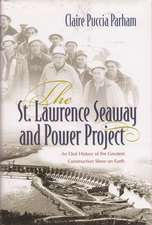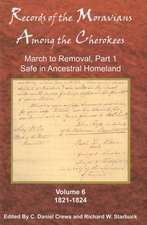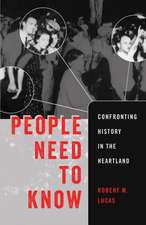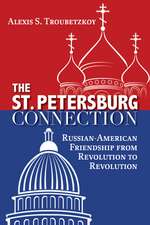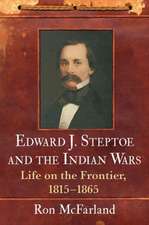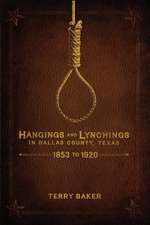Founders and Famous Families of Cincinnati
Autor Wendy Hart Beckmanen Limba Engleză Paperback – 2 iun 2014
From its very beginnings, Cincinnati offered an enticing combination of personable welcome and worldly sophistication. At one point, Cincinnati had more native-born residents than any other American city, a testament to the values that attracted and retained its citizens.
In Founders and Famous Families of Cincinnati, author Wendy Hart Beckman brings to life the founding families’ histories, sharing these intertwined and fascinating tales with readers near and far. A charming history of lives lived large -- truly the Who’s Who (as well as the When and Where) of Cincinnati -- that when considered together, made the Queen City the great place to live and work that it is today.
Preț: 102.25 lei
Nou
19.57€ • 21.32$ • 16.49£
Carte disponibilă
Livrare economică 02-16 aprilie
Specificații
ISBN-10: 1578605210
Pagini: 190
Ilustrații: B&W photos throughout
Dimensiuni: 150 x 226 x 13 mm
Greutate: 0.27 kg
Editura: Clerisy Press
Cuprins
2. 1780s and 90s: First Families
3. 1800s and 10s: Settlement in Cincinnati and Statehood for Ohio
4. 1820s and 30s: Manufacturing and Steamboats — The River Is King
5. 1840s and 50s: Changes in Transportation and Government
6. 1860s and 70s: Building a City
7. 1880s and 90s: Explosive Population Growth
8. 1900s and 10s: Rifts and Tensions
9. 1920s and 30s: Water, Water Everywhere
10. 1940s and 50s: Cincinnati Goes to War
11. 1960s and 70s: Open and Closed Doors
12. 1980s and 90s: More Reasons to Party
13: 2000s and 10s: The Dawn of a New Century
14. The Future
Recenzii
—Ann Hagedorn, author of Wild Ride, Beyond the River, and more.
Notă biografică
WENDY HART BECKMAN is an award-winning freelance writer and editor Founders and Famous Families: Cincinnati is her seventh work of nonfiction. She has also published more than 300 articles in print and online publications, and has received a baker's dozen of awards for her writing, editing, and desktop publishing. Wendy's bachelor's degrees are in geology and natural science/technical communications from Virginia Polytechnic Institute & State University and the University of Cincinnati, respectively. She also has a master's degree in English from UC with a graduate certificate in professional writing. She has taught English, business writing, and scientific and technical writing at the University of Cincinnati and cultural diversity at Miami University. She frequently offers workshops, from a few hours in length to weekend-long retreats, for writers who wish to get published. Besides writing, Wendy's passion lies in singing. For 10 years she was a member of the Cincinnati May Festival Chorus, the oldest continuous choral tradition in the Western hemisphere. When she's not engaged in writing or singing, she can be found with one of her paintball teams, working on behalf of the nonprofit that she co-founded, Athletes Joined Against Spondylitis. She lives in Cincinnati with her husband and three sons.
Extras
Founders and Famous Families of Cincinnati traces and unravels the interwoven stories about the founding families who made Cincinnati what it is today. Many history books about the United States start with a story of how Europeans discovered virgin land, claimed it for their countries, and gave it a name. If the land they discovered had inhabitants, the “discoverers” named them, too. But our story of Cincinnati starts a little differently. For one thing, it wasn’t always called “Cincinnati.”
More than 400 million years ago, a shallow inland sea covered what we would later call Cincinnati. But for now, we’ll call it “Crinoid City,” for this sea was full of marine animals like brachiopods, coral, bryozoans and tulip-like crinoids. When these critters died, their calcium-rich shells became part of the fossiliferous limestone in future Cincinnatians’ mantles, retaining walls and garden walkways. In fact, Cincinnati has the best fossils in the world from this phase of geologic time, known as the Ordovician Period. If it weren’t for our natural humility, this age might have been named “the Cincinnatian Period,” instead.
But when it came to actually naming our fair city, some folks in the 18th century were a little more forward. Matthias Denman, Israel Ludlow and Robert Patterson bought 800 acres from John Cleves Symmes, who had been given a charter by the new Continental Congress to settle this area. Symmes had purchased a large section of land north of the Ohio River and bordered by the Little and Great Miami rivers, hoping to establish a settlement — thereby making himself wealthy along the way.
Surveyor John Filson — with Denman, Ludlow and Patterson’s help — named their plot of land “Losantiville,” which they declared meant “city across from the mouth of the Licking River.” “L” was for the Licking River; “os” is Latin for “mouth,” “anti” means “opposite”; and “ville” is French for “town” or “village.”
So Losantiville it was — for about a year. Then General Arthur St. Clair, newly named governor of the Northwest Territory, named it “Cincinnati” after the Society of the Cincinnati, of which he was a member. Around Cincinnati, however, you can still find remnants of “Losantiville,” such as Losantiville Country Club in Pleasant Ridge or Losantiville Avenue in Golf Manor.
But we’re getting ahead of ourselves. Let’s go back to Cincinnati’s geology briefly.
We’re going to skip from the fossils of Ordovician Period in the Paleozoic Era to the Pleistocene Period in the Cenozoic Era. In non-geologic terms, we are now talking about ~1 million years ago. At this point, there are still no humans. But there are glaciers — three of them, in fact, that we’re concerned with — first the Kansan, then the Illinoian and finally the Wisconsinan. These three glaciers carved out the valleys and hills that made Cincinnati what it is today, topographically. Prior to that, the main body of water (called the “Teays River” by geologists) flowed northerly, which is why the Licking River flows northerly. It fed the Teays as it now feeds the Ohio. So Cincinnati was born as the city across from the Licking River.
The city proper lies in the bottom of a bowl surrounded by the hills that were pushed into shape by the geological forces of nature. The bowl was created by tectonics and the convergence of the Licking, Ohio, Little Miami and Great Miami rivers. The walls of the bowl, which once protected early settlers, have also served as a natural windbreak — making the Ohio Valley a catch basin for allergens and airborne particulates. No wonder Cincinnati has earned one of its other nicknames: the sinus capital of the world, thanks to its hills.
And what about those hills? Ask any Cincinnatian how many hills the city has, and he or she will quickly answer “seven!” But if you ask that same friendly Cincinnatian to name those seven hills, you might find your new friend has become a little tongue tied. Why? Because there are more than just seven hills surrounding the city. Here are a few of the “seven” hills: Clifton Heights, College Hill, Fairmount, Fairview Heights, Mt. Adams, Mt. Airy, Mt. Auburn, Mt. Lookout, Mt. Echo, Mt. Storm, Mt. Healthy, Mt. Washington, Price Hill, the Vine Street Hill and Walnut Hills. (The highest of these is Mt. Airy, with an elevation of 938 feet above sea level.)
When General Arthur St. Clair changed the name of the city to Cincinnati, he was naming it for the Society of the Cincinnati, of which he was a member. The society honored those who fought during the Revolutionary War and was named for Cincinnatus of ancient Rome — the original city of seven hills. So one modern-day theory is that Cincinnatians felt that because Rome had seven hills, so should we.
Another common theory is that the hills closest to the downtown area were the “original” seven hills, only to be later eclipsed by taller hills farther out. In the 19th century, “inclines” were built on five of the hills, thus allowing pedestrians and horse cars to travel swiftly from the bottom of the bowl to the summits for business, for recreation or to just enjoy the scenery.
Today, many people are attracted to Cincinnati by its combination of arts, sports, industry and state-of-the-art healthcare facilities. Although it is the third-largest city in Ohio, Cincinnati still offers a healthy amount of green spaces with plenty of opportunities to get back to nature. Within an easy half-hour drive, you could be in farmland or the middle of the woods. At one point in the 1980s, Cincinnati was even named the greenest city in America.
When I prepared to move here 32 years ago, I encountered an interesting phenomenon: it seemed as though everyone had either lived here at one time or knew someone who did. It was as if Cincinnati was everyone’s home. Rather than being a great place to visit but you wouldn’t want to live there, Cincinnati is a great place to live but sometimes people don’t think of vacationing here!
But it is worth a visit — and those things that make it worth visiting are the same attractions and treasures that made me dig my feet in both times I found myself jobless so far away from my New England roots. When I was younger, my parents begged me to move back home, but I knew I had found a home right here — and the reason is the result of the Founding Families described in this book.
Cincinnati possesses a unique combination of elements:
down-home hospitality, common to many Midwestern cities
small-town feel, thanks to all the neighborhoods annexed by Cincinnati
big-city amenities like several universities and professional sports franchises
world-renowned fine arts: the second-oldest opera company in the United States, the oldest continuous choral group (the May Festival Chorus), the fifth-oldest symphony orchestra, plus the Cincinnati Arts Museum and much more
cutting-edge healthcare: three hospitals in the top ranks nationally with many more hospitals highly ranked in specialty areas ranging from pediatrics to geriatrics
business leaders: 10 Fortune 500 companies are headquartered here, three Fortune 500 global companies are headquartered here, with 15 Fortune 1000 companies and more than 360 Fortune 500 companies having some kind of presence.
When I considered whom to include in this book, two things became evident over and over: the great Cincinnatians don’t stay in neat little categories like business, fine arts, healthcare, education or politics. The founding families — and the future families are continuing it — may have made their mark in one area, soap for example, but they also contributed to the welfare of their fellow Cincinnatians in other “arenas.” Sometimes literally.
James Norris Gamble, son of Procter & Gamble co-founder James Gamble, donated the football stadium to the University of Cincinnati in memory of his grandson, James Gamble Nippert (who died as a result of a Thanksgiving football game in 1923). Carl Lindner, Sr., made his early fortune as a milk man, coming up with the first “cash and carry” dairy store in Cincinnati, naming it “United Dairy Farmers.” His son, Carl H. Lindner, carried on the UDF tradition but established and grew many other businesses, as well. He was a great patron of the arts and was also part-owner of the Cincinnati Reds at one time.
So how did I choose which founding families to include in this book? After much mulling, I came up with a set of criteria. The founding families in this book did some combination of the following:
Played an important role in moving Cincinnati forward. For example, John Cleves Symmes got the original charter to settle this area.
Are composed of multiple members or generations who contributed to Cincinnati’s or Cincinnatians’ existence. For example, several generations of Gambles contributed to Cincinnati, as discussed above.
Had a name that modern Cincinnatians would recognize in some way. Nippert Stadium? Symmes Township?
Are of national importance, perhaps. (John Cleves Symmes’ daughter married William Henry Harrison, who became the ninth president and served for 32 days before dying of natural causes.)
I ignored the differences between those people who were born in Cincinnati and those who emigrated here. John Cleves Symmes was born in New York. But he would later get a charter to come out west, to what was at the time the last bastion of civilization. And that’s where our story begins.

